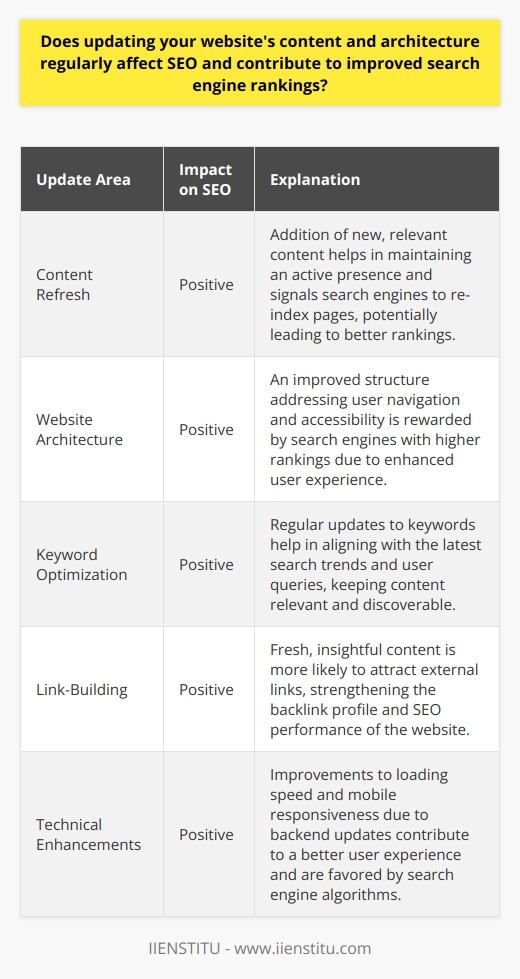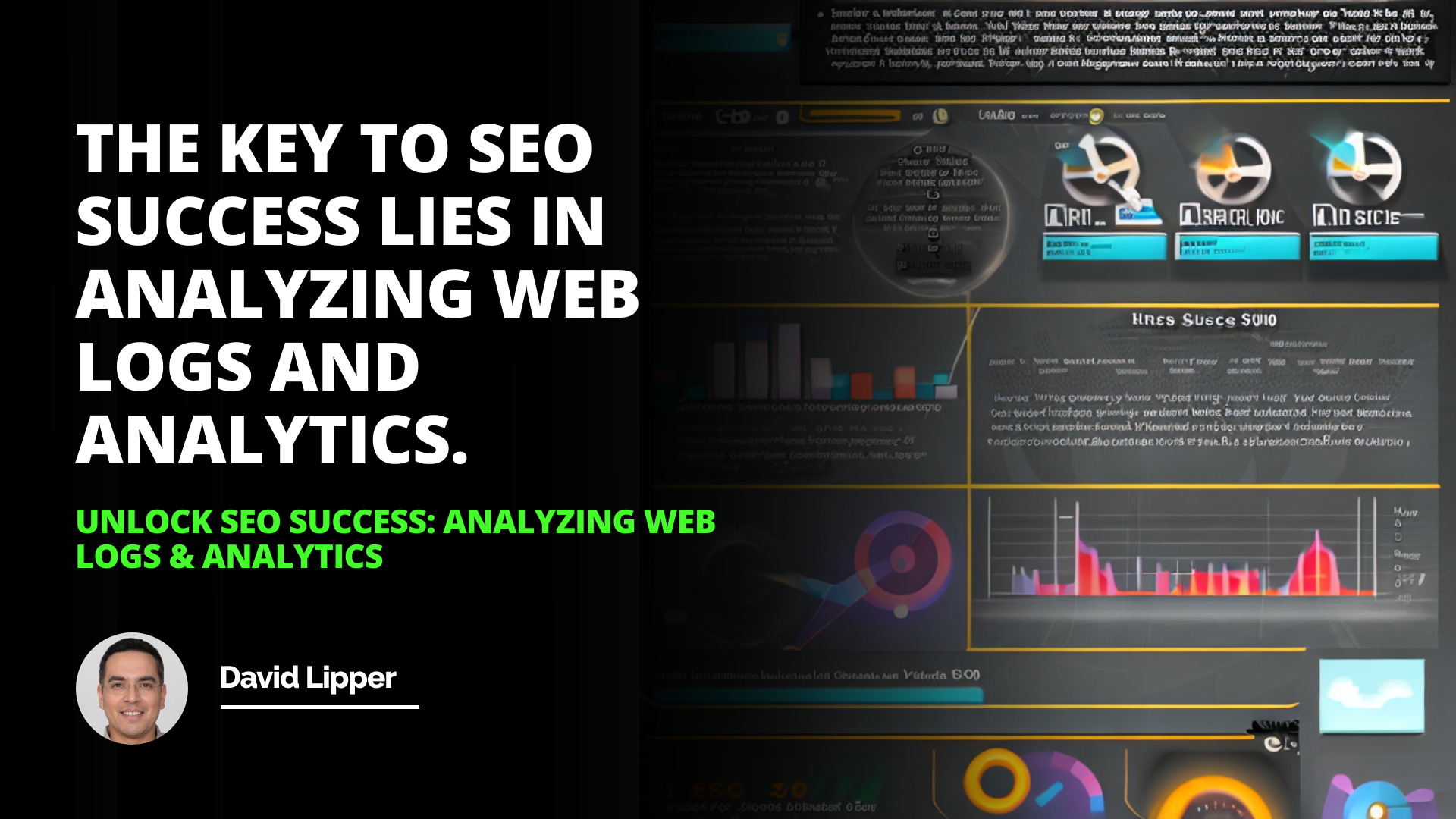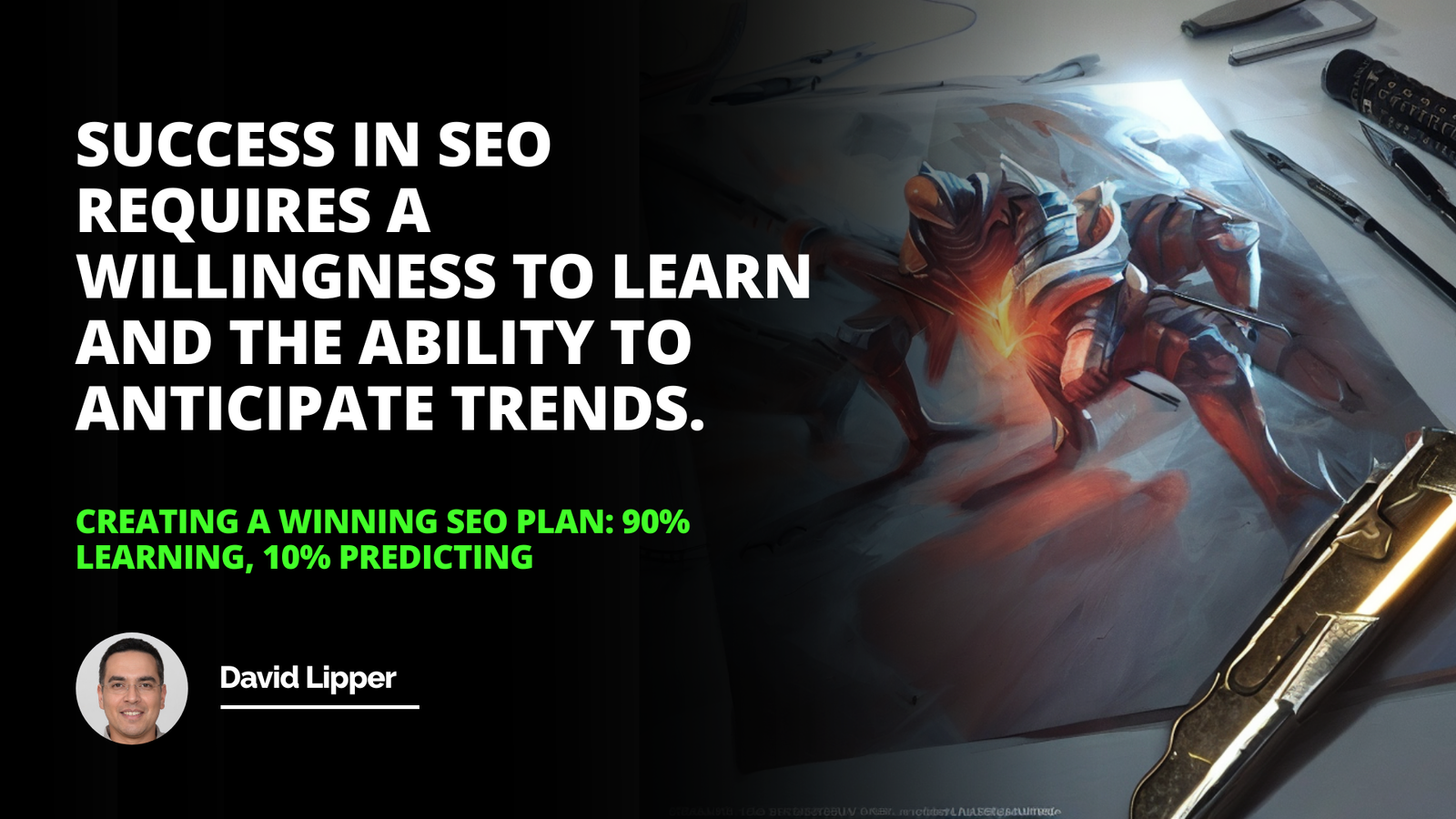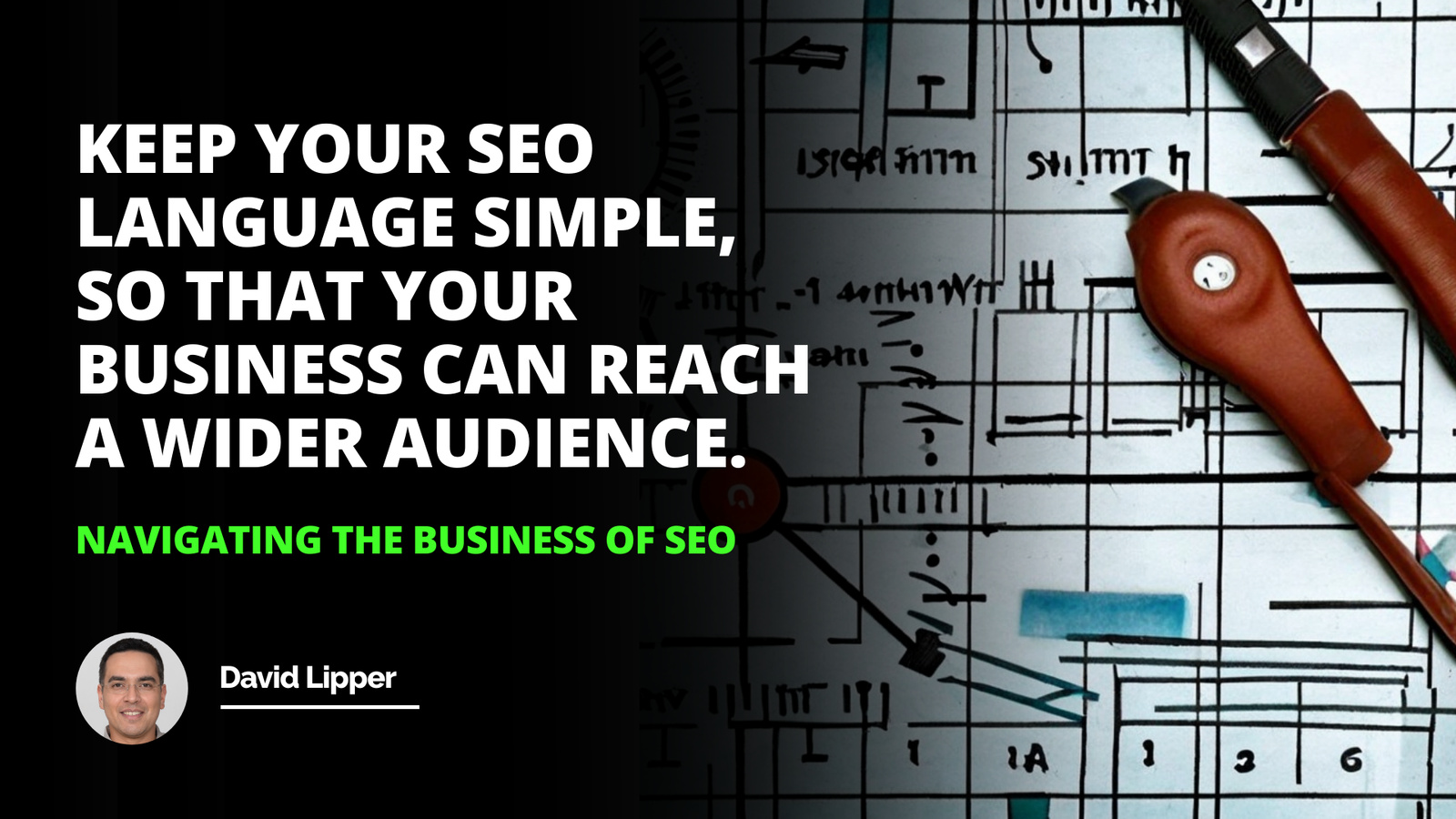Tracking website changes is essential for SEO success. Changes to the website can directly impact SEO, and tracking changes can help monitor progress and identify potential problems before they become serious. Examples of site changes affecting SEO include adding content areas, changing the domain name, modifying URL structures, and implementing a new CMS.
Strategies for tracking site changes include setting up a log to record all changes and having a designated person or team responsible for tracking changes. Through tracking website changes, organizations can ensure their SEO projects are successful.
Introduction
Reasons to Track Site Changes
Examples of Site Changes That Affect SEO
Strategies for Tracking Site Changes
Conclusion
Tracking Site Changes for SEO Success
The success of any SEO project depends heavily on the ability to track website changes. There are many reasons why tracking site changes is essential, ranging from the impact of changes on SEO to the ability to monitor progress. This article will discuss why tracking site changes is essential, provide examples of site changes that can impact SEO, and suggest strategies for tracking site changes.
Why Track Site Changes?
There are many reasons why tracking site changes is essential for SEO success. First, changes to the website can have a direct impact on SEO. For example, adding a new content area or changing the domain name can affect how search engines crawl and index the site. Second, tracking changes can help monitor progress.
Knowing which changes have been made and when can help identify which changes have impacted SEO and which have not. Finally, tracking changes can help identify potential problems before they become serious. By keeping an eye on changes to the website, it is possible to spot potential issues before they become serious.
Examples of Site Changes That Affect SEO
There are many types of site changes that can have an impact on SEO. Some of the most common examples include adding content areas, changing the domain name, modifying URL structures, and implementing a new content management system (CMS).
Adding content areas can affect how search engines crawl and index the site while changing the domain name can have a significant impact if not managed properly with 301 redirects. Modifying URL structures can also affect SEO, as can implementing a new CMS.
Strategies for Tracking Site Changes
There are several strategies for tracking site changes. Ideally, all changes to the website should be tracked, though this may not always be possible, especially if IT and engineering services are outsourced. In larger organizations, many different people can make changes to the website that can impact SEO, so it is essential to have a system in place to track changes.
One strategy is to set up a log that records all changes to the website. Another strategy is to have a designated person or team responsible for tracking changes and ensuring they are communicated to the rest of the organization.
Conclusion: Tracking website changes is essential for SEO success. Changes to the website can directly impact SEO, and tracking changes can help monitor progress and identify potential problems before they become serious.
Examples of site changes affecting SEO include adding content areas, changing the domain name, modifying URL structures, and implementing a new CMS. Strategies for tracking site changes include setting up a log to record all changes and having a designated person or team responsible for tracking changes. By tracking website changes, organizations can ensure that their SEO projects are successful.
Staying on top of website changes is the key to achieving SEO success.
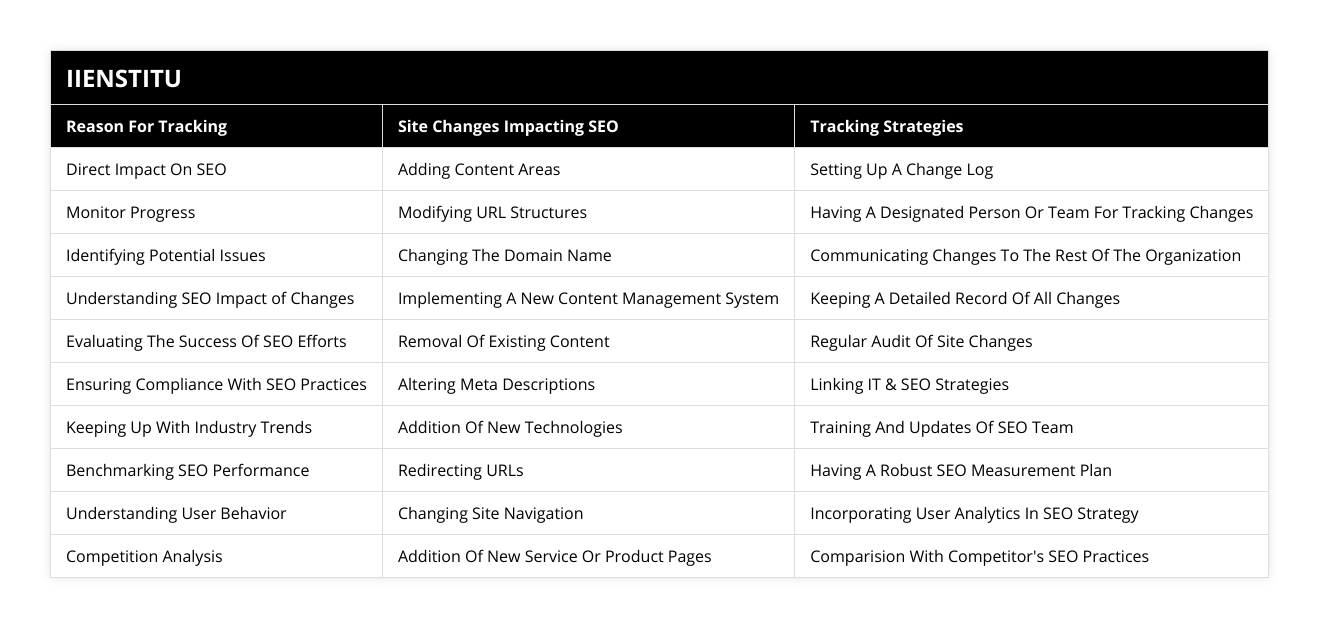
Frequently Asked Questions
What are the benefits of tracking site changes for SEO success?
Tracking site changes is an essential part of SEO success. By understanding the changes made to a website, businesses can monitor their SEO activities and adjust accordingly. This article will discuss the benefits of tracking site changes for SEO success.
Firstly, tracking site changes allows businesses to analyze the impact of their SEO activities. By monitoring the changes made to a website, businesses can assess whether their SEO efforts positively impact them. This includes understanding how changes to the website have affected the rankings in the SERP, the amount of traffic to the website, and the conversion rate.
Secondly, tracking site changes enables businesses to identify areas for improvement. By monitoring changes made to a website, businesses can identify areas that need to be improved to achieve SEO success. For example, businesses can identify areas where content needs improvement, or link-building efforts need to be increased.
Thirdly, tracking site changes allows businesses to stay up-to-date with the latest SEO trends. By monitoring the changes to a website, businesses can identify any new trends or changes in the SEO landscape and adjust accordingly. This can help businesses stay ahead of the competition and maximize their SEO success.
Finally, tracking site changes can help businesses identify potential technical issues. By monitoring the changes made to a website, businesses can quickly identify any potential technical issues impacting their SEO success. By resolving these issues, businesses can improve their SEO performance.
In conclusion, tracking site changes is an essential part of SEO success. By understanding the changes made to a website, businesses can monitor their SEO activities and adjust accordingly. Tracking site changes allows businesses to analyze the impact of their SEO activities, identify areas for improvement, stay up-to-date with the latest SEO trends, and identify potential technical issues.

What are some examples of site changes that can affect SEO?
Search engine optimization (SEO) is a process used by website owners to increase the visibility of their website in search engine results pages (SERPs). This is done by implementing specific tactics and strategies that address the three primary components of SEO: technical, on-site, and off-site.
To maximize the effectiveness of SEO tactics, website owners must ensure that their website is constantly up-to-date with the latest changes to ensure that the major search engines can find it. Below are some examples of site changes that can affect SEO.
1. Content: Content is the most crucial factor in SEO. Content should be well-written, informative, and relevant to the website's topic. Content should also be unique and original, as duplicate content can affect SEO negatively. Furthermore, content should be regularly updated with fresh and engaging content to keep visitors engaged and to ensure that search engine algorithms can index the website correctly.
2. URLs: URLs are the web addresses of a website. URLs should be short, descriptive, and keyword-rich to ensure that search engines can properly index the website. Additionally, URLs should be optimized for search engines to increase the chances of a website being found.
3. Meta Tags: Meta tags are snippets of text describing a web page's content. They should include keywords relevant to the page's content and should be optimized for search engines.
4. Image Optimization: Images are a vital part of a website and should be optimized for search engine crawlers. This includes adding descriptive alt text, making sure that the file size of the images is small, and ensuring that the images are properly compressed.
5. Internal Linking: Internal linking is a great way to improve a website's user experience and ensure that search engine crawlers can adequately crawl the website. Internal links should be relevant and descriptive to ensure users can find the content they want.
These are just a few examples of site changes that can affect SEO. Website owners should be mindful of these changes and implement them to ensure that their website is correctly optimized for search engines and can be found by their target audience.
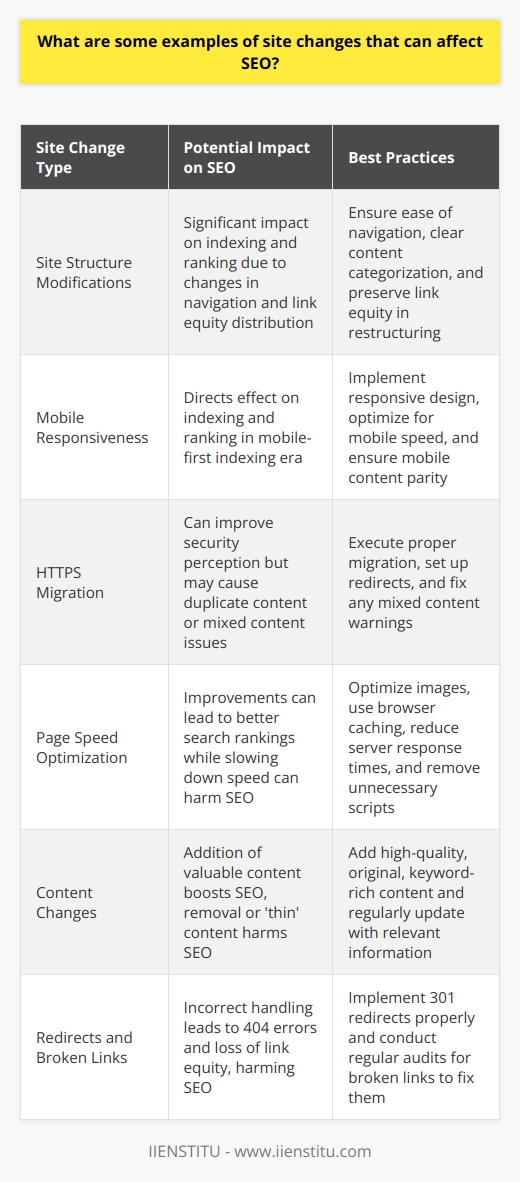
What strategies can be used to track site changes for SEO success?
To ensure SEO success, it is essential to track site changes. Tracking site changes helps to monitor any changes that have been made to a website and can help to identify potential issues that may be affecting its SEO performance. In this article, we will discuss some strategies that can be used to track site changes for SEO success.
The first strategy for tracking site changes for SEO success is to use an analytics platform. Analytics platforms provide detailed insights into website performance, such as page visits, views, and bounce rates. This data can be used to identify any changes that may have been made to a website, such as a page content, page structure, or page titles, which can then be adjusted accordingly to optimize its performance.
The second strategy for tracking site changes for SEO success is to use a website audit tool. A website audit tool comprehensively analyzes a website’s performance and identifies any potential issues affecting its SEO performance. This includes identifying broken links, duplicate content, or other issues impacting a website’s performance.
The third strategy for tracking site changes for SEO success is to use a search engine optimization (SEO) tool. SEO tools can help to identify any changes that may have been made to a website that may be affecting its SEO performance. For example, an SEO tool can identify changes to page titles, meta descriptions, or keyword usage that may impact a website’s SEO performance.
Finally, the fourth strategy for tracking site changes for SEO success is to use a website monitoring tool. Website monitoring tools can help to identify any changes that may have been made to a website that may be affecting its SEO performance. This includes monitoring changes to page content, page structure, page titles, and other elements impacting a website’s SEO performance.
In conclusion, there are a variety of strategies that can be used to track site changes for SEO success. These include using an analytics platform, a website audit tool, an SEO tool, and a website monitoring tool. It is essential to use these strategies to monitor any changes made to a website and identify any potential issues that may be affecting its SEO performance.
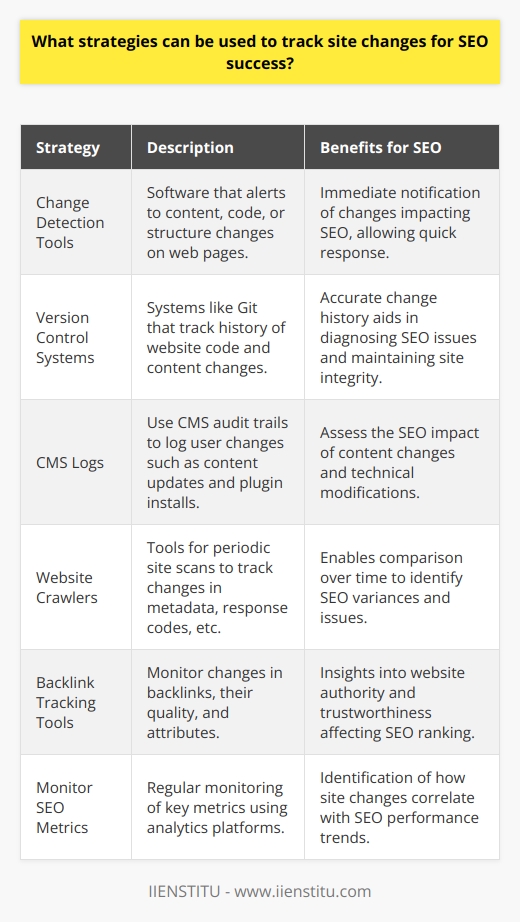
What are the key components to monitor when tracking SEO changes and their impact on website performance?
Assessing SEO Components
In evaluating the effectiveness of search engine optimization (SEO) practices and comprehending alterations in website performance, specific key components merit continuous monitoring. These comprise organic traffic, click-through rate, and backlinks, which ultimately influences the site's standing within search results.
Analyzing Organic Traffic
Organic traffic constitutes the primary metric gauged to comprehend SEO changes' effects. Utilizing tools such as Google Analytics enables accurate assessments of visitor numbers and their origins. Monitoring these fluctuations can divulge whether SEO modifications yield improvement or necessitate further scrutiny.
Delving into Click-through Rates
Monitoring click-through rates (CTR), which represent the percentage of viewers who click on a website link after viewing it in search results, provides insights into the pertinence and appeal of content. High CTR correlates with captivating, relevant material that appeals to the user, thus boosting website performance. Low CTR could signify the requirement for headline or meta description alterations, endorsing additional optimization.
Evaluating Backlink Profiles
An essential component of any successful SEO campaign is a healthy and diverse backlink profile. Analyzing factors such as the number, quality, and relevance of incoming links from credible external sources helps to determine how search engines perceive a website's authority in its specific field. Tools like Ahrefs or Moz can facilitate backlink tracking and scrutiny.
Tracking Keyword Rankings
Identifying and examining shifts in keyword rankings plays an indispensable role in estimating the influence of SEO changes. Improved rankings on search engine results pages (SERPs) signify definite progress, while deteriorating rankings can uncover the necessity for content or keyword targeting enhancement.
Conducting Technical Audits
Lastly, periodically conducting comprehensive technical audits ensures the overall health and performance of the website. Paramount aspects to scrutinize include crawlability, mobile-friendliness, and page load speed, as well as structured data protocols. Addressing any identified issues can contribute to an enhanced user experience and optimized search engine compliance.
In conclusion, effectively tracking SEO changes and their impact on website performance necessitates thorough examination and ongoing evaluation of distinct components, addressing both users' engagement and search engines' standards. By prioritizing these factors, businesses can optimize their online presence and achieve superior rankings in search results.
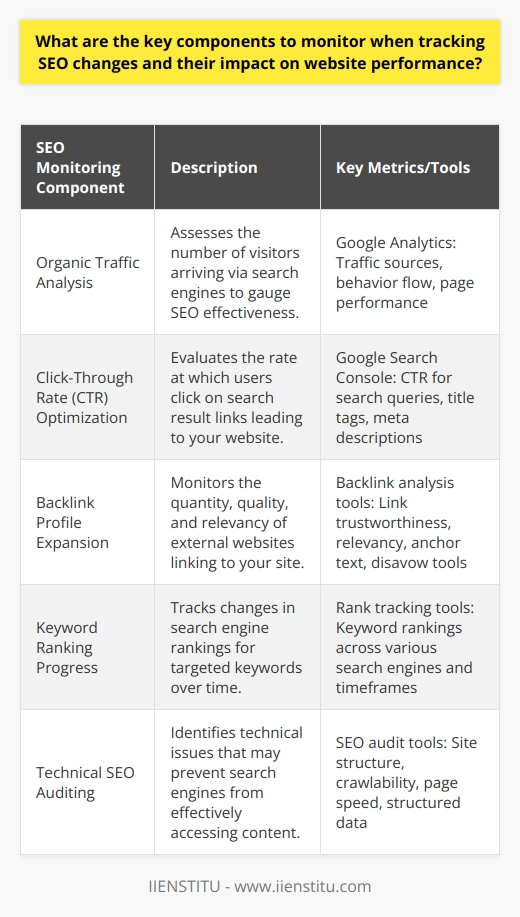
How can the effectiveness of SEO modifications be accurately assessed in relation to website traffic and user engagement?
Measuring SEO Effectiveness through Website Traffic
One effective method to accurately assess the effectiveness of SEO modifications in relation to website traffic is by analyzing specific metrics, including the number of users who visit the website, the average time they spend on the site, and the number of pages they view per session. These three indicators allow for a comprehensive understanding of how SEO changes have impacted the overall traffic and user engagement.
Utilizing Google Analytics for SEO Assessment
Google Analytics, a widely used tool for measuring website performance, offers valuable insights to understand the impact of implemented SEO modifications. While analyzing metrics such as organic search traffic and average session duration, one can evaluate the effectiveness of the SEO changes in driving more visitors and achieving higher user engagement.
Examining Bounce Rates for User Engagement
Another suitable metric to study user engagement on a blog post is the bounce rate, which represents the percentage of visitors who leave the website after viewing only one page. An effective SEO strategy would ideally lead to a lower bounce rate as users find the content more relevant, engaging, and valuable, which in turn can lead to higher session durations and multiple page views.
Delving into Conversion Rates for In-depth Analysis
Conversion rates provide a more comprehensive outlook on the effectiveness of SEO modifications by measuring the percentage of website visitors who complete the desired action, such as subscribing to a newsletter or submitting a contact form. A well-implemented SEO strategy would likely result in higher conversion rates, as the visitors will find the content more appealing and be compelled to act as desired.
Assessing User Engagement through Social Shares
Lastly, the number of social shares a blog post receives is an indirect yet representative method to gauge the quality of the content and its impact on user engagement. As effective SEO modifications may lead to improved content visibility, a higher number of social shares implies that the users find the post worthy of sharing within their networks, thereby increasing the overall visibility and effectiveness of the SEO strategy.
In conclusion, by analyzing multiple performance metrics, including website traffic, user engagement, and conversion rates, the effectiveness of SEO modifications can be accurately assessed. By employing various tools such as Google Analytics and monitoring social shares, businesses and content creators can determine the success of their SEO strategies and continue to optimize for enhanced performance.
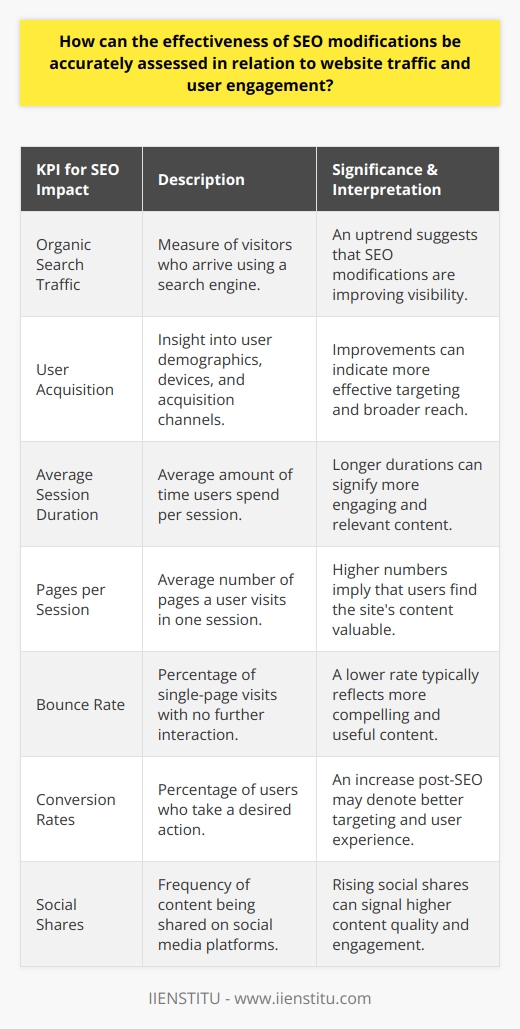
What specific metrics should be prioritized to ensure continuous SEO improvement and optimal website performance?
Key Metrics to Prioritize for SEO Improvement
Keyword Ranking Improvement
First and foremost, tracking keyword ranking progress stands essential in improving SEO. By monitoring target keywords' placement over time, any positive or negative changes in rankings can be identified, and necessary adjustments can be made to the SEO strategy accordingly.
Website Traffics and Click-Through Rate
Another important metric to prioritize is website traffic, which includes metrics such as the number of unique users, new users, page views, and bounce rate. Analyzing these patterns will help in understanding the behavior of the target audience and optimizing website content accordingly. Additionally, click-through rate (CTR) should be analyzed to measure how effectively the website communicates its information, ultimately leading to website optimization.
Domain Authority Score
Domain authority, a composite score reflecting a website's overall relevancy to its niche, significantly impacts search engine rankings. Frequently auditing domain authority ensures that a website continues to build trust with search engines through high-quality content, consistent linking profiles, and relevant keywords.
Backlink Analysis
Backlinks remain vital for any website's SEO status. Prioritizing backlink analysis paves the way for understanding which backlinks contribute positively to a website's search engine rankings and which need to be addressed or removed. Additionally, monitoring the backlink profiles of competitors can help drive valuable insights for future SEO improvements.
User Metrics
Focusing on user metrics such as average session duration, pages per session, and return visitor ratio will provide insights into user experience and engagement. These metrics are crucial for understanding how visitors interact with the website and identifying areas for improvement. Better user experience undoubtedly leads to better search engine rankings.
Mobile Responsiveness
As mobile-first indexing has become the standard for search ranking criteria, ensuring a website's mobile responsiveness is crucial. To optimize website performance, regularly testing mobile loading speeds and addressing any issues encountered must be a priority. Improving mobile and overall website performance consistently contributes to higher search engine rankings.
In conclusion, regularly tracking and optimizing these specific metrics are crucial in achieving continuous SEO improvement and optimal website performance. In doing so, businesses drive organic visibility, attract higher volumes of quality traffic, and establish authority in their respective niches.
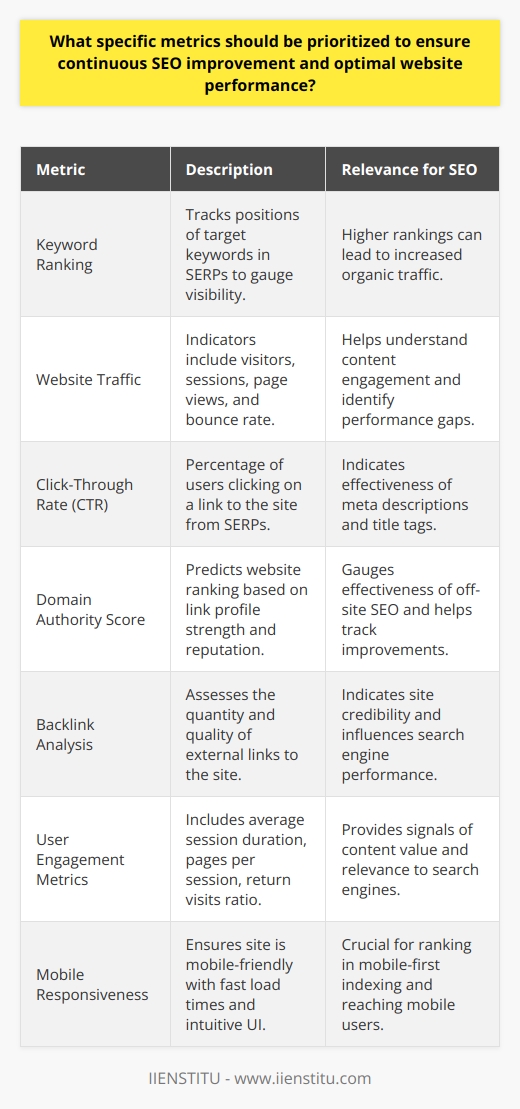
How can you effectively monitor the impact of website modifications on SEO performance and search rankings?
Monitoring Website Modifications
To effectively monitor the impact of website modifications on SEO performance and search rankings, it is essential to utilize various analytical tools and implement a systemic approach. Firstly, make a record of every modification made to the website to have a clear understanding of the changes implemented.
Using Analytical Tools
One popular tool to measure the SEO performance is Google Analytics, which provides data on website traffic, user behavior, and engagement. Additionally, Google Search Console can help in analyzing the website's performance in Google search results, indexing status, and crawl errors that might affect the site's ranking.
Evaluating On-Page SEO
On-page SEO involves optimizing the content, meta tags, header tags, and images to improve the website's visibility on search engines. Utilizing tools like Moz or SEMrush can help in gauging the effectiveness of on-page SEO after implementing modifications. These tools provide insights on keywords, meta tags, and header tags, enabling you to compare the pre- and post-modification performance.
Assessing Off-Page SEO
Off-page SEO focuses on activities performed outside the website, such as link building and social media marketing. Monitoring the impact of website modifications on off-page SEO can be done through tools like Ahrefs, which examines backlinks, domain authority, and referring domains. Monitoring the changes in these parameters after the website modifications can help in assessing their effectiveness.
Tracking Page Speed
Website loading speed is another critical factor affecting search rankings. Google's PageSpeed Insights, GTmetrix, and Pingdom are tools that can help monitor and optimize the loading speed of a website. Comparing the page speed before and after website modifications will reveal their effects on user experience and search engine rankings.
Monitoring User Experience
Lastly, surveying user experience can help in understanding the impact of website changes on the overall experience. Tools like Hotjar and Crazy Egg can give insights into user behavior patterns and heatmaps, assisting you in making informed decisions on further modifications.
In conclusion, a combination of analytical tools and a systematic approach in monitoring on-page and off-page SEO, page speed, and user experience will effectively determine the impact of website modifications on search rankings and performance.
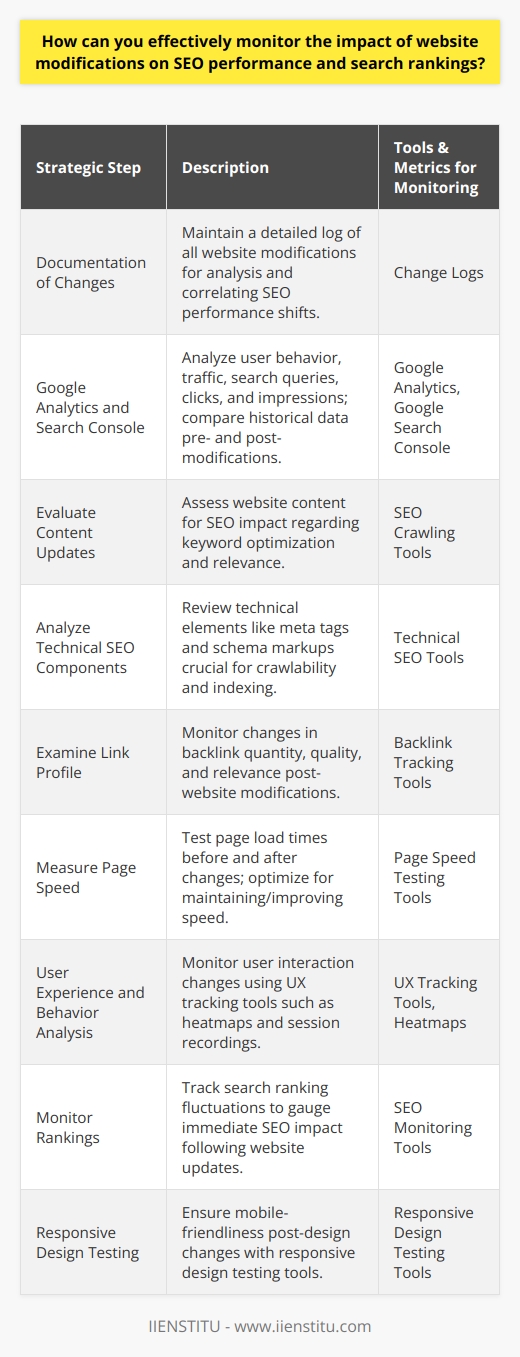
What are the essential metrics and indicators to track when monitoring SEO progress and analyzing website performance?
Essential Metrics for Monitoring SEO Progress
Keyword Rankings: One of the primary metrics to monitor while evaluating SEO progress is the keyword rankings, which indicates the visibility of a website in search engine result pages (SERPs) for specific keywords.
Organic Traffic: Analyzing the number of organic visitors not only offers insight into the effectiveness of SEO strategies, but also exhibits the overall interest in a website's content or products.
Bounce Rate: A high bounce rate signifies that visitors leave a webpage without interacting further, reflecting a lack of engaging content and ineffective optimization strategies.
Time on Site: The duration of time a user spends on a website is indicative of the site's relevance to its visitors; hence, keeping track of this metric can demonstrate the effectiveness of a website's content.
Click-Through Rate (CTR): CTR, the ratio of clicks on a website's link to its total impressions, can be employed as an indicator of the site's relevance and appeal to users.
Pages per Session: Monitoring the average number of pages a user views per session can reveal a website's navigational functionality and the effectiveness of internal linking strategies.
Conversion Rate: Evaluating the percentage of visitors who perform desired actions, such as making a purchase or signing up for a newsletter, provides valuable information on user experience and content optimization.
Backlinks: A critical off-site SEO indicator, the quantity and quality of backlinks connecting to a website, demonstrates the site's authority and credibility within its respective industry.
Domain Authority: This metric, calculated by third-party tools, predicts a website's search engine ranking potential and provides an easy-to-understand summary of a site's overall SEO performance.
On-page Metrics: On-page optimization involves user-focused elements such as meta tags, URL structure, and readability, and measuring these aspects can suggest improvements for more effective SEO.
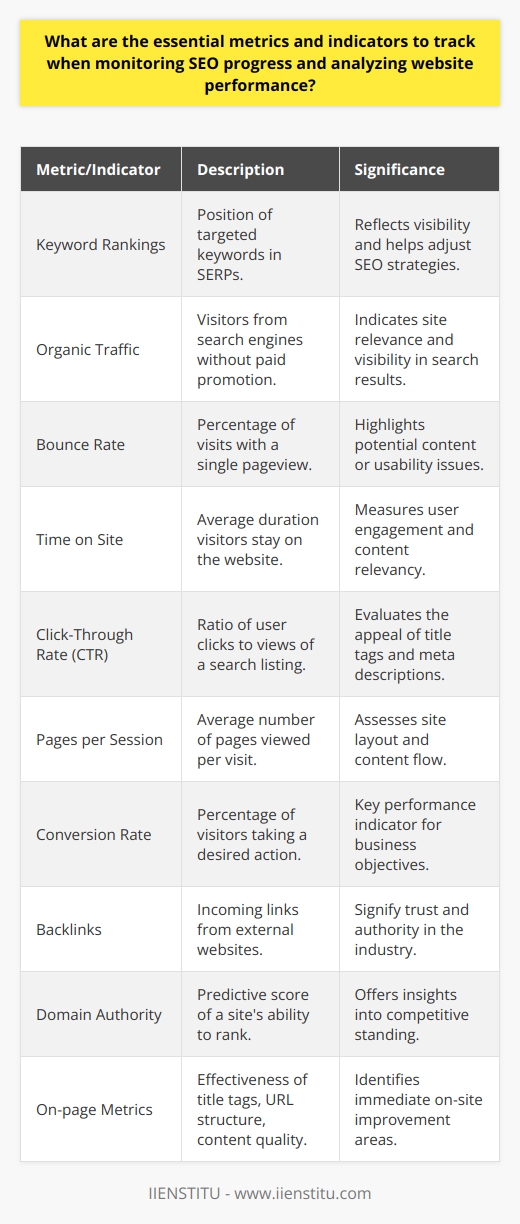
How frequently should one review and update their website's content and overall structure to ensure continued SEO optimization and search engine visibility?
Frequency of Content Review and Update
One must frequently review and update their website's content and overall structure to ensure continued SEO optimization and search engine visibility. Various factors determine the frequency of content review and update, including industry trends, niche-specific requirements, competition, and target audience activity. As a general recommendation, updating a website at least once per month is considered effective for maintaining SEO performance.
Analyzing Website Performance Metrics
To determine the appropriate frequency of content updates, website administrators must closely track performance metrics. For instance, monitoring website traffic, bounce rates, and user engagement data provides insights that guide effective content review and update strategies. Moreover, tracking keyword rankings helps evaluate whether the website is maintaining its relevance in search results. A drop in keyword positions or a deterioration of engagement metrics might indicate a need for more frequent content updates.
Responding to Market Needs and Competition
Ensuring that a website's content and structure remain relevant to the current market trends and industry requirements is crucial for maintaining SEO performance. Regularly reviewing keyword strategies, analyzing competitor websites, and keeping an eye on emerging trends helps administrators make informed decisions about updating website content. Also, incorporating innovative techniques such as voice search or mobile-first design can improve overall site performance and keep the website ahead of its competition.
Updating Evergreen Content for Continued Success
Evergreen content typically retains its relevance over longer periods, but it still requires periodic updates to ensure continued search engine visibility. Updating such content with the latest information, adjusting keyword strategy, and modifying the structure to accommodate changing user preferences are crucial for maintaining its SEO value. As industry standards and best practices evolve, it is critical to adjust evergreen content accordingly.
Tailoring Content to Target Audience Interests
Lastly, understanding and catering to the target audience's preferences and interests ensures the website's content remains relevant and clickable. Regularly updating content to address users' changing needs and preferences is key to attracting and retaining traffic. Administering user surveys, conducting A/B tests, and monitoring social media trends can provide valuable insights to re-evaluate and update the website's content.
In conclusion, regularly reviewing and updating website content and structure is vital for ensuring continued SEO optimization and search engine visibility. Administrators must pay close attention to performance metrics, market trends, competition, evergreen content, and target audience interests to make informed decisions about the frequency of content updates.
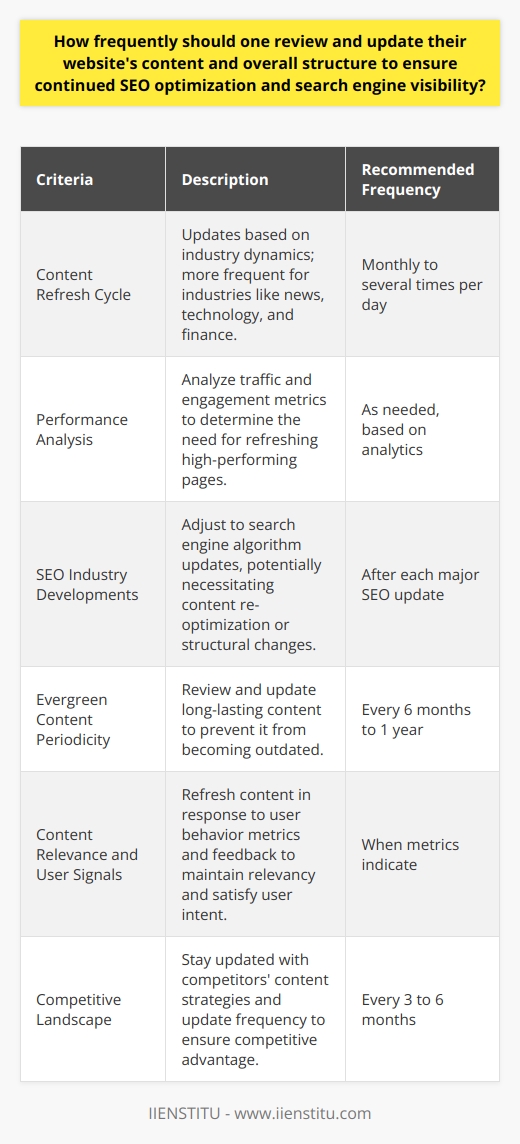
How would you monitor the effectiveness of SEO?
Measuring SEO Performance
To monitor the effectiveness of search engine optimization (SEO) strategies implemented on a blog post, various analytics tools and key performance indicators (KPIs) can be utilized. These tools and metrics facilitate the assessment of the website's visibility on search engines, user engagement, and conversion rates.
Utilizing Analytics Tools
A vital step in monitoring SEO effectiveness is employing analytics tools such as Google Analytics, Moz, or SEMrush. These platforms offer comprehensive data on website performance, enabling the identification of areas needing improvement and adjustment of SEO strategies accordingly.
Tracking Keyword Rankings
Monitoring the position of targeted keywords on search engine result pages (SERPs) provides insight into the effectiveness of keyword research and optimization efforts. Significant fluctuation in rankings or consistently low keyword rankings indicates the need for re-evaluation of the keyword strategy.
Analyzing Organic Traffic
Assessing the volume and quality of organic traffic to the blog post is crucial in determining the success of SEO efforts. A steady increase in organic traffic indicates that the website is gaining visibility on search engines and attracting relevant users with well-optimized content.
Evaluating Click-Through Rates (CTRs)
Click-through rates measure the ratio of users who click on a particular listing in SERPs to those who view the listing. High CTRs suggest that the title tags and meta descriptions are effective in attracting users, while low rates may call for further optimization to be more appealing and relevant to users.
Calculating Bounce Rates
Bounce rates refer to the percentage of visitors who immediately leave a website after viewing a single page. High bounce rates on a blog post may signal that the content is not meeting users' expectations, necessitating improvements in content quality and user experience.
Measuring Conversion Rates
A decisive way to judge the effectiveness of SEO is to examine conversion rates, which quantify the percentage of visitors who complete a desired action, such as subscribing to a newsletter or making a purchase. Achieving high conversion rates suggests that not only is the blog post attracting relevant traffic but also persuading users to engage with the website further.
In conclusion, monitoring the effectiveness of SEO requires a comprehensive approach, utilizing analytics tools and various key performance indicators to evaluate the website's visibility, user engagement, and ability to convert incoming traffic. This ongoing process ensures the continuous optimization of a blog post and improvement in its overall performance.
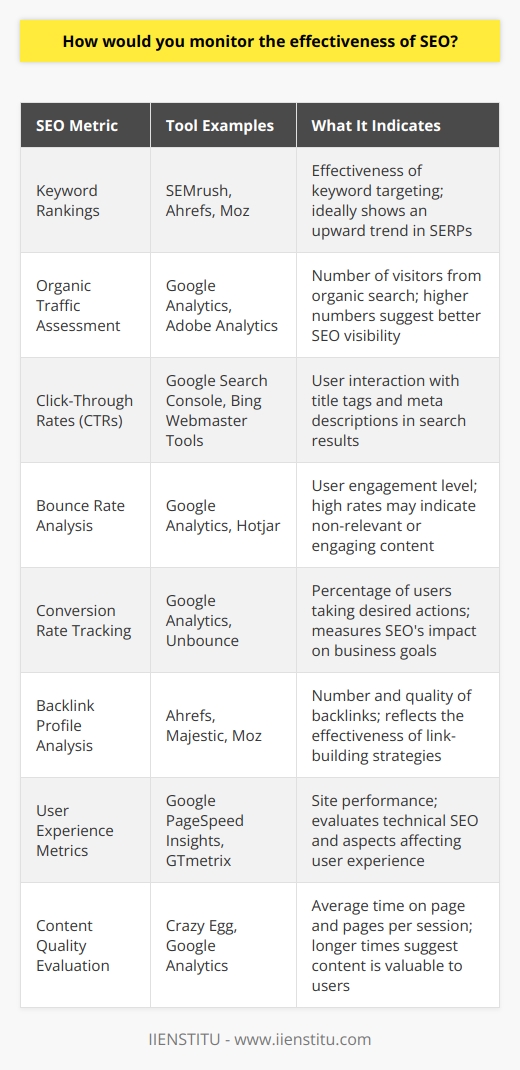
What are the tracking metrics for SEO?
Tracking Metrics for SEO
Overview of Metrics
Effective Search Engine Optimization (SEO) strategies rely on a multitude of tracking metrics that help assess a website's performance and indicate areas for improvement. These metrics, which can be monitored through various analytical tools, provide valuable insights into user traffic, engagement, and overall site ranking.
User Traffic Metrics
A key component of evaluating SEO effectiveness is monitoring user traffic by analyzing several crucial metrics. For instance, organic search traffic, which refers to visitors who find a website through search engines, is an essential measure of successful SEO strategies. Other important traffic indicators include referral traffic, direct traffic, and the total number of page views and sessions.
Engagement Metrics
To assess user engagement on a website, studying metrics such as bounce rate, average session duration, and pages per session proves beneficial. A low bounce rate indicates that the content is relevant to users and encourages them to explore more of the site. Similarly, longer average session duration and higher pages per session suggest that users find the content valuable and engaging.
Keyword Ranking Metrics
Tracking targeted keyword rankings is crucial for evaluating a website's visibility on search engine results pages (SERPs). A higher ranking for relevant keywords not only increases visibility, but it also demonstrates the effectiveness of SEO strategies. Additionally, monitoring fluctuations in keyword rankings can help identify opportunities to optimize content and improve SERP positioning.
Conversion Metrics
Ultimately, the success of SEO efforts depends on achieving set goals or conversions, such as sales, sign-ups, or downloads. Tracking conversion rate, which is the percentage of website visitors who complete a desired action, provides a direct indication of SEO success. Analyzing conversion data offers insights into user behavior and helps guide future optimization efforts.
In conclusion, understanding and monitoring the aforementioned tracking metrics is vital to develop and refine SEO strategies. By assessing user traffic, engagement, keyword ranking, and conversion data, website administrators can make informed decisions to improve performance and enhance user experience.
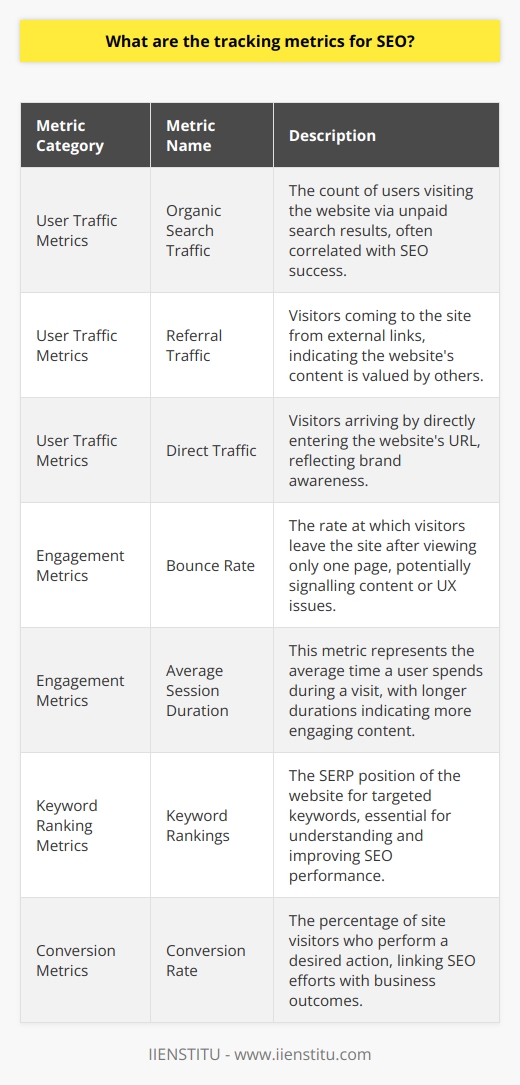
How long does it take for website changes to affect SEO?
Time Frame for SEO Changes
The impact of website changes on search engine optimization (SEO) primarily depends on the type and extent of the modifications made. Generally, noticing an effect on SEO results may take anywhere from a few days to several months.
Crawl and Indexing Time
First, we must consider the time it takes for search engines to crawl and index the updated website content. Typically, crawl frequency relies on several factors, including website popularity, content freshness, and crawl budget. Hence, well-established websites with regular updates may experience quicker indexing and subsequently reflect SEO changes sooner.
On-Page Modifications
Another determinant of the time frame for SEO impact is the nature of the modifications implemented. For instance, on-page changes such as altering meta tags, headings, and content optimization may show faster results compared to more substantive modifications. If your on-page tweaks align with search engine guidelines and user intent, you may observe visibility improvements within a few days to a few weeks.
Off-Page Alterations
On the other hand, off-page adjustments like building high-quality backlinks, boosting social media presence, and enhancing the website's domain authority may take longer to see results. These updates involve establishing relationships, generating organic traffic, and improving overall website credibility, which typically require persistence and consistency over weeks or months.
Technical Enhancements
Lastly, technical improvements like enhancing site speed, fixing crawl or index errors, and implementing structured data can also contribute to changes in SEO performance. Such enhancements mainly focus on improving user experience, which search engines highly value. Thus, while their results may not be instantaneous, they undoubtedly play a vital role in boosting the website's visibility in the long-term.
In summary, the time it takes for website changes to affect SEO varies depending on the crawl and indexing period, the nature of the modifications—whether on-page, off-page, or technical—and the quality of implementation concerning search engine guidelines and user intent. Therefore, it is crucial to continually monitor SEO performance, adjust strategies according to analytical insights, and maintain consistency to maximize the website's organic search visibility.
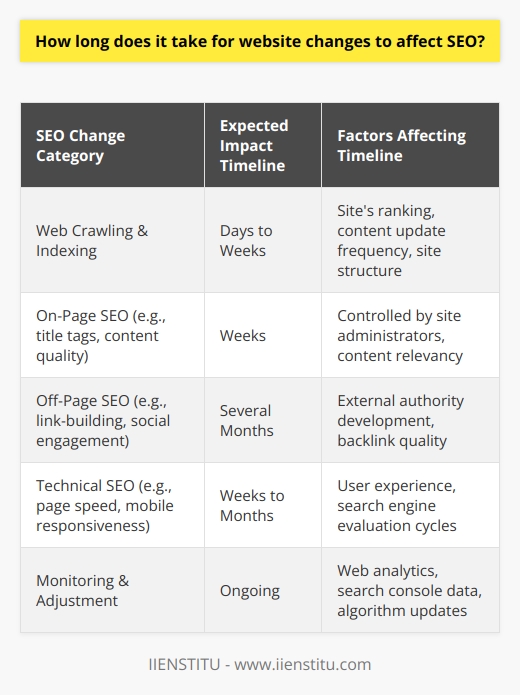
How often should you adjust sites for SEO optimization?
Frequency of SEO Adjustments
In the ever-evolving landscape of search engine optimization (SEO) marketing, it is crucial to constantly update and refine a website's content and structural elements, in order to maintain or improve its visibility on search engine results pages (SERPs) and attract the target audience. With this in mind, the frequency of making SEO adjustments should be determined by a number of factors, including industry trends, algorithm updates, and website performance metrics.
Monitoring Industry Trends and Algorithm Updates
One of the main drivers behind the need for frequent SEO adjustments is the ongoing evolution of search engine algorithms, which are designed to serve the most relevant and useful content to their users. As search engines constantly refine their criteria for ranking websites, it is necessary for site owners to stay current with the latest best practices and adapt their strategies accordingly. Moreover, industry trends in content creation and user behavior may also influence the effectiveness of existing SEO tactics, making it critical to monitor these developments and adjust the site's content and optimization accordingly.
Analyzing Performance Metrics and User Engagement
The need for SEO adjustments should also be informed by the website's performance data and user engagement metrics. Regularly analyzing these statistics, such as organic traffic, bounce rate, and conversion rate, helps site owners identify aspects that may need improvement, as well as emerging opportunities for targeting specific keywords or user segments. Additionally, keeping track of user feedback and engagement data, such as comments and social media interactions, can guide site owners in refining their content strategies and making any necessary SEO adjustments.
Iterative Approach to SEO Optimization
Given the frequent changes in search engine algorithms, industry trends, and user behavior, a proactive and iterative approach to SEO optimization is recommended. This involves continuous monitoring of website performance, user engagement, and industry developments, along with a commitment to making consistent updates and refinements as needed. While there is no one-size-fits-all answer to how often a website should be adjusted for SEO optimization, an ongoing commitment to learning and evolving in response to these factors will ensure that a site remains visible and engaging to its target audience.

What are the essential elements to consider when implementing SEO strategies to maximize website ranking and organic traffic?
Keyword Research and Selection
Firstly, the foundation of any successful SEO strategy lies in thorough keyword research and selection. Identifying the most relevant and valuable search terms for your website's content will directly impact its ranking on search engine results pages (SERPs). Moreover, by choosing keywords with high search volume and low competition, you can increase the likelihood of attracting organic traffic to your site.
On-Page Optimization
After selecting the right keywords, it is crucial to optimize your website's content according to those terms. This process, called on-page optimization, involves several elements. Primarily, the strategic use of keywords in title tags, meta descriptions, headings, and the body text can help search engines understand and index your content effectively. Additionally, maintaining a logical site structure with clear, concise URLs and a well-organized internal linking system can further facilitate indexing and enhance user experience.
Mobile Responsiveness
In today's digital landscape, mobile responsiveness is a crucial factor in SEO. A website that performs well on multiple devices will not only satisfy user expectations but also achieve higher ranking on SERPs, as search engines favor sites that offer a seamless browsing experience. Therefore, implementing responsive design and optimizing site speed are essential in maximizing your website's organic traffic.
Quality Content and User Experience
Another critical aspect of an effective SEO strategy is the consistent creation of high-quality, relevant, and informative content. By meeting the needs and expectations of your target audience, you can establish your website as an authoritative and reliable source of information. In turn, this improves your site's credibility and increases its chances of being shared or linked to by other reputable websites, thus boosting SEO performance. Furthermore, focusing on user experience through seamless navigation, clear calls to action, and visually appealing design can contribute to higher dwell times and lower bounce rates, which positively impacts search ranking.
Link Building
Lastly, acquiring high-quality external links is an indispensable part of any SEO strategy. This process, known as link building, not only increases your website's visibility on search engines but also bolsters credibility in the eyes of users and search engines. Obtaining backlinks from reputable websites within your niche or industry through strategies such as guest blogging, outreach, and collaboration can significantly enhance your site's performance and bring in valuable organic traffic.
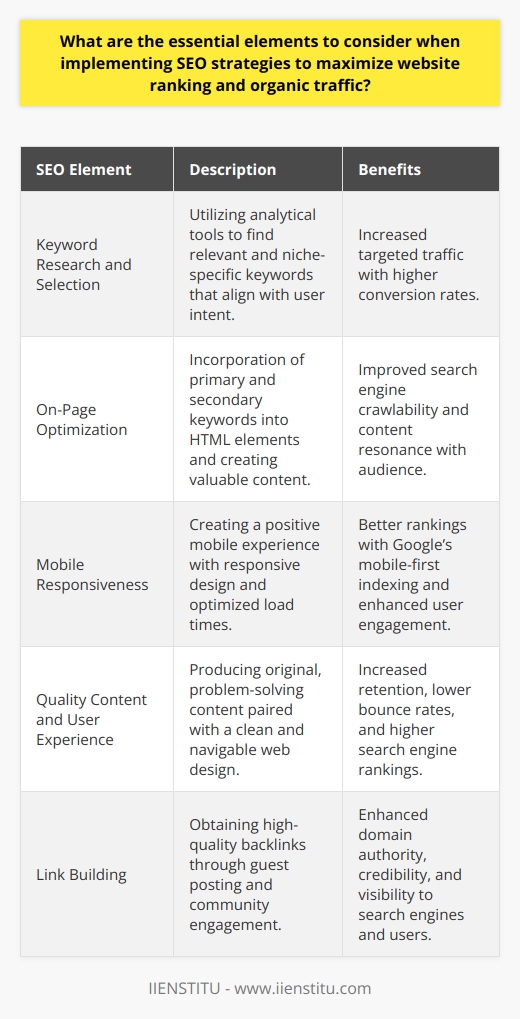
What role do search algorithms and user behavior play in determining the effectiveness of SEO modifications?
Role of Search Algorithms
Search algorithms constitute the primary mechanism through which search engines like Google rank and display content in response to user queries. These algorithms analyze several factors such as relevance, authority, and overall quality of a webpage. Therefore, understanding and adapting to the evolving nature of search algorithms is vital for implementing effective SEO modifications that boost a website's search ranking.
Influence of User Behavior
User behavior, including click-through rates (CTR), time spent on a website, and bounce rates, directly impacts the effectiveness of SEO modifications. As search algorithms consider these behavioral factors to determine a website's relevance to a search query, it is crucial to optimize website content so that it effectively engages users and positively influences their online behavior.
Balancing Algorithm Changes and User Engagement
To optimize the effectiveness of SEO modifications, website owners need to monitor and adapt to changes in search algorithms while simultaneously improving user engagement. This can be achieved by producing high-quality, relevant content that satisfies user intent, incorporating attractive design elements, and ensuring an optimal user experience. Moreover, continuous analysis and monitoring of website traffic and user behavior data are essential to tailor effective SEO strategies and maintain a competitive edge in the search rankings.
In conclusion, search algorithms and user behavior play pivotal roles in determining the effectiveness of SEO modifications to enhance a website's search ranking. In order to optimize SEO efforts, website owners must remain up-to-date on algorithm changes, maintain a strong focus on user engagement, and routinely analyze data to ensure content aligns with user intent and drives positive user behavior.
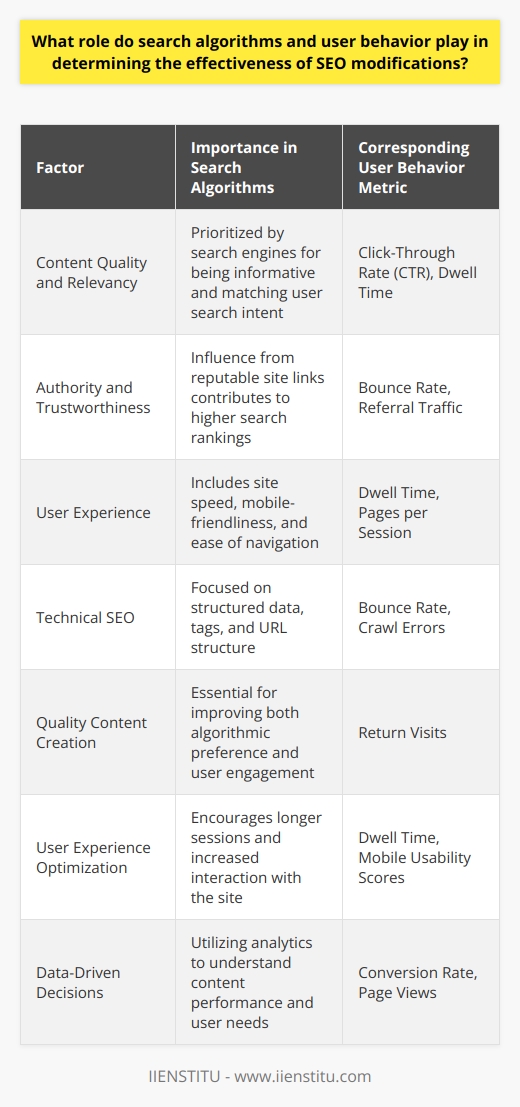
How do you monitor the effectiveness of SEO strategies and their impact on website traffic and user engagement?
Measuring SEO Effectiveness
To monitor the effectiveness of SEO strategies and their impact on website traffic and user engagement, one must employ a variety of quantitative and qualitative measurement tools. Doing so ensures that SEO techniques yield optimal results in terms of increased traffic and user engagement on the blog.
Utilizing Web Analytics
Web analytics platforms, like Google Analytics, play a significant role in assessing a website's performance. These tools provide data on key metrics, such as the number of visitors, page views, average session duration, and bounce rate. Monitoring these metrics allows for insights into the overall effectiveness of SEO efforts, achieved through higher rankings on search engine results pages.
Understanding Organic Traffic
Organic traffic, which refers to website visitors originating from unpaid search results, is an essential indicator of successful SEO implementation. By analyzing organic traffic data, one can determine which SEO techniques are driving traffic to the blog, thereby allowing for informed adjustments and optimization.
Evaluating Keyword Rankings
Monitoring a blog's keyword rankings is crucial for determining the success of SEO initiatives. Using tools like Google Search Console, one can track changes in keyword positions and identify potential areas of improvement. Higher keyword rankings typically correlate to increased visibility and, consequently, improved website traffic and user engagement.
Assessing User Engagement
User engagement metrics, such as click-through rates (CTR), time on page, and pages per session, can provide valuable insights into how users are interacting with the content. Improved user engagement often signifies effective SEO strategies, as visitors are likely to find the content relevant and accessible.
Implementing A/B Testing
Lastly, A/B testing is an essential method for identifying the most effective SEO techniques and optimizing a blog. By comparing the performance of two variations, A/B testing allows for targeted improvements, resulting in increased website traffic and user engagement.
In summary, closely monitoring key metrics through web analytics, organic traffic data, keyword rankings, user engagement, and A/B testing ensures that SEO strategies effectively increase website traffic and user engagement on a blog. Regular analysis and adjustment of tactics can lead to continuous improvement and optimization, resulting in a highly successful and engaging blog.
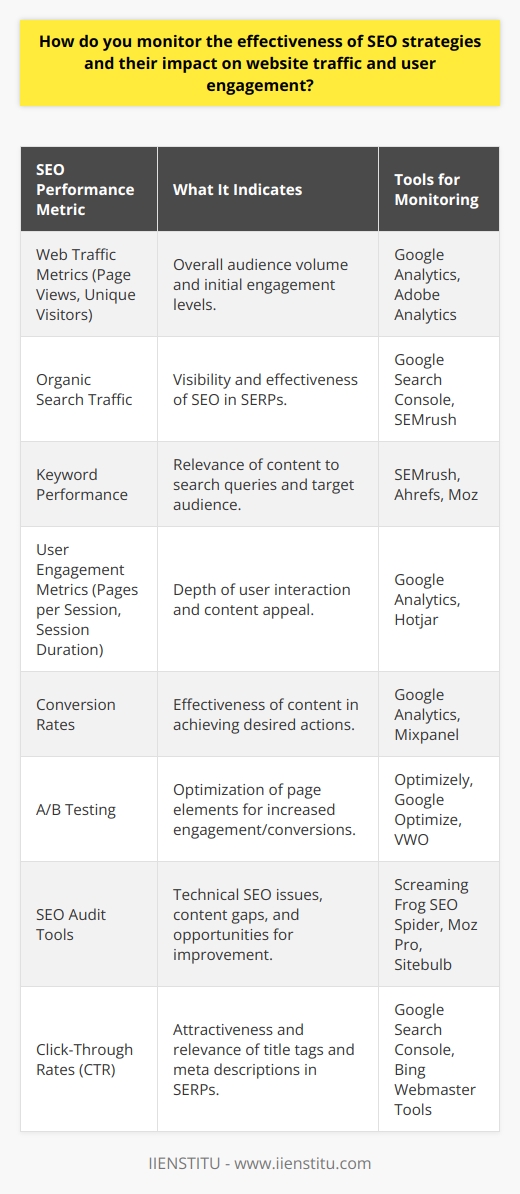
Why is tracking the results of SEO efforts crucial for maintaining and improving search engine rankings and visibility?
**The Importance of Monitoring SEO Results**
Tracking the results of SEO efforts is essential for maintaining and improving search engine rankings and visibility for several reasons. Firstly, analyzing the performance of SEO strategies enables businesses to determine which tactics are working and which ones need improvement. This allows companies to fine-tune their efforts and allocate resources effectively, ensuring a better return on investment.
**Adaptation to Algorithm Changes**
Secondly, search engine algorithms are constantly evolving. To maintain high visibility in search results, businesses must adapt to these changes. By monitoring SEO outcomes, it is possible to identify any drops in rankings following algorithm updates. This information can then be used to make necessary adjustments, ensuring that the website remains competitive in search results.
**Understanding User Behavior and Preferences**
An additional reason for tracking SEO outcomes is to gain insights into user behavior and preferences. By examining data on user engagement and website traffic, companies can better understand what content resonates with their target audience. This knowledge can then be used to create more appealing content, further enhancing search engine visibility and attracting more qualified traffic.
**Evaluating Competitor Performance**
Lastly, closely monitoring SEO results allows businesses to assess their competitor's performance. This competitive analysis enables companies to unearth new keywords and strategies that they may not have previously considered, providing an opportunity to gain an edge over rival businesses. By staying informed about competitor activities, organizations can adjust their own strategies to capture additional market share and improve their overall search engine visibility.
In conclusion, tracking the results of SEO efforts is a crucial aspect of maintaining and improving search engine rankings and visibility. This practice supports informed decision-making by enabling businesses to evaluate the effectiveness of their strategies, adapt to algorithm changes, understand user behavior and preferences, and assess competitor performance. By consistently monitoring and adjusting their SEO approach based on these insights, companies can ensure that they remain competitive in the ever-changing landscape of search engine optimization.

How often should you reevaluate and update your website's content and overall architecture to ensure continued SEO optimization and high search engine performance?
Frequency of Content Evaluations:
To ensure continued SEO optimization and high search engine performance for your blog, it is essential to reevaluate and update your website's content and overall architecture regularly. Ideally, you should conduct a comprehensive assessment and make relevant updates at least once every three to six months.
Importance of Fresh Content:
Updating your website's content, such as blog posts, images, and videos, is crucial to maintain a high level of engagement with your target audience. Search engines, such as Google, prioritize fresh and relevant content to provide users with the most up-to-date information. Regular content updates not only improve your search engine rankings but also encourage user interaction, leading to increased time spent on your site and potential conversions.
Optimizing Site Architecture:
In addition to updating content, the architecture of your website should also be examined and modified as necessary. This process involves analyzing your site's structure, navigation, and usability to ensure that it remains user-friendly and accessible to both humans and search engine bots. Modifications to the website's architecture may include adding or removing pages, improving internal linking structures, and optimizing page titles and meta descriptions.
Analyzing Performance Metrics:
To effectively update your blog's content and architecture, it is important to monitor performance metrics, such as bounce rate, click-through rate, and time on site. These analytics can provide insight into the effectiveness of your current content strategy and site architecture, enabling you to make data-driven decisions when updating your blog. Additionally, tracking keyword rankings and organic traffic can help you measure the impact of your SEO efforts and identify areas for improvement.
Adapting to Algorithm Changes:
One of the most challenging aspects of maintaining a blog's SEO optimization is adapting to search engine algorithm changes. Google and other search engines consistently update their algorithms to provide users with a better search experience. Staying informed about these updates and modifying your blog's content and architecture accordingly is essential for maintaining high search engine performance.
In conclusion, reevaluating your blog's content and overall architecture at least every three to six months is critical to ensure continued SEO optimization and high search engine performance. Doing so will help you keep your content fresh, enhance site usability, adapt to algorithm changes, and make improvements based on performance metrics.
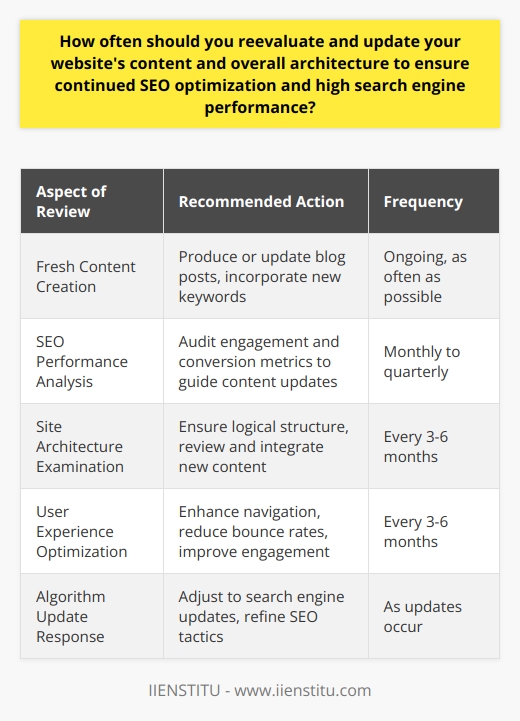
How do you monitor the effectiveness of SEO strategies in adapting to search engine algorithm updates and shifts in user behavior?
Evaluation of SEO Strategies
To determine the efficacy of SEO strategies for adapting to search engine algorithm updates and shifts in user behavior, constant observation and analysis become imperative.
Keyword Tracking
Firstly, Keyword ranking plays a pivotal role. Marketers often use keyword ranking tools to determine where their website ranks. A drop in keyword ranking indicates a need for strategy revision.
Traffic Analysis
Secondly, analyzing web traffic is valuable. You can use tools like Google Analytics to observe changes in website traffic. Less traffic suggests an ineffective SEO strategy.
On-site Engagement
Thirdly, monitoring on-site engagement helps in understanding user behavior. Bounce rate and average time spent on the website signal user engagement level.
Monitoring Backlinks
Lastly, backlink tracking remains crucial in SEO strategy effectiveness. A decrease in the quantity or quality of backlinks suggests an ineffective strategy.
Adapting to Algorithm Changes
Adaptation to algorithm updates involves constant website analysis to understand if performance is hampered. If update-related website issues are detected, SEO strategies must be adjusted to compensate.
Understanding User Behavior
For user behavior shifts, study the changes in user demographics, interaction, and site preferences. This understanding will facilitate changes in your strategy to better cater to your audience.
In conclusion, by using a combination of these approaches, it becomes possible to efficiently monitor SEO strategy effectiveness. Using these insights, strategies can be updated to ensure continuous adaptation to algorithm updates and shifts in user behavior.
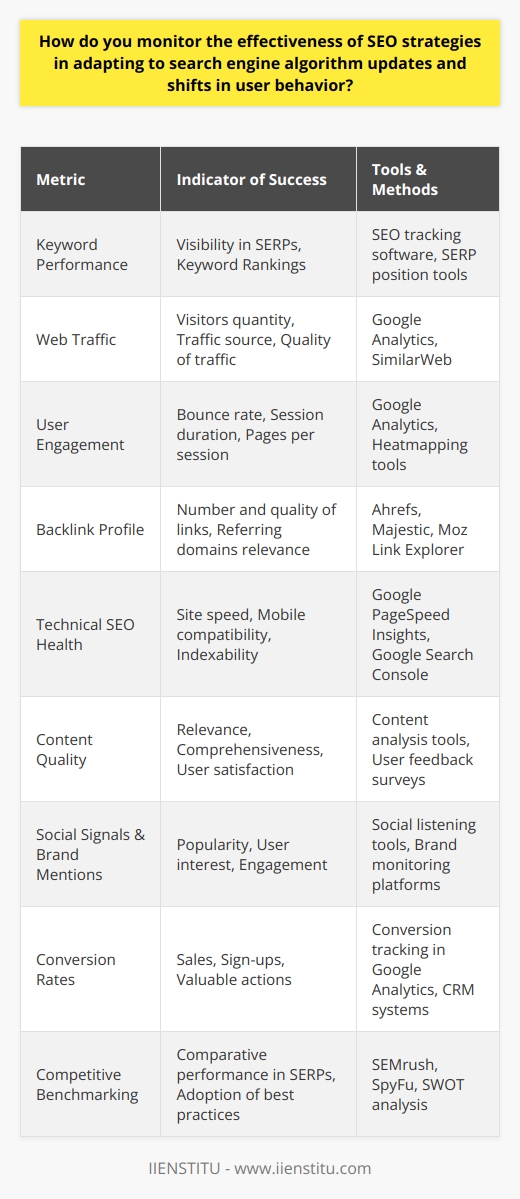
Why is SEO tracking essential in identifying areas for improvement and opportunities for growth in search engine rankings and organic traffic?
Identifying Improvement Areas
SEO tracking offers pivotal information regarding website performance. It helps identify weak spots that have potential for enhancement. This could include overlooked or underperforming keywords, issues with website structure, or content quality and relevancy.
Keyword Optimization
Focusing particularly on keywords, SEO tracking helps identify words and phrases that are not effectively driving traffic. By tracking the effectiveness of specific keywords, changes to keyword strategy can be made to enhance organic search traffic.
Improving Website Structure
SEO tracking can also uncover issues with website structure. Poor website structure can negatively impact user experience and search engine crawlers. Adjustments to website navigation and internal linking can significantly improve website indexing and crawling by search engines.
Content Quality and Relevancy
Additionally, SEO tracking helps in assessing content relevancy and quality. Engaging and relevant content plays a crucial role in ranking well in search engine results. In-depth tracking can provide invaluable insights into changes that can be made to improve content quality and thereby increase organic traffic.
Uncovering Growth Opportunities
SEO tracking not only highlights areas for improvement, but also uncovers growth opportunities. This could include underutilized high performing long-tail keywords or potential links from high authority sites. Capitalizing on these opportunities can result in improved search engine rankings and organic traffic.
In summary, SEO tracking forms the backbone of any successful SEO strategy, assisting in identifying areas for potential improvement and growth opportunities. Without thorough SEO tracking, optimizing for search engine rankings and organic traffic becomes a guessing game rather than strategic decision-making.
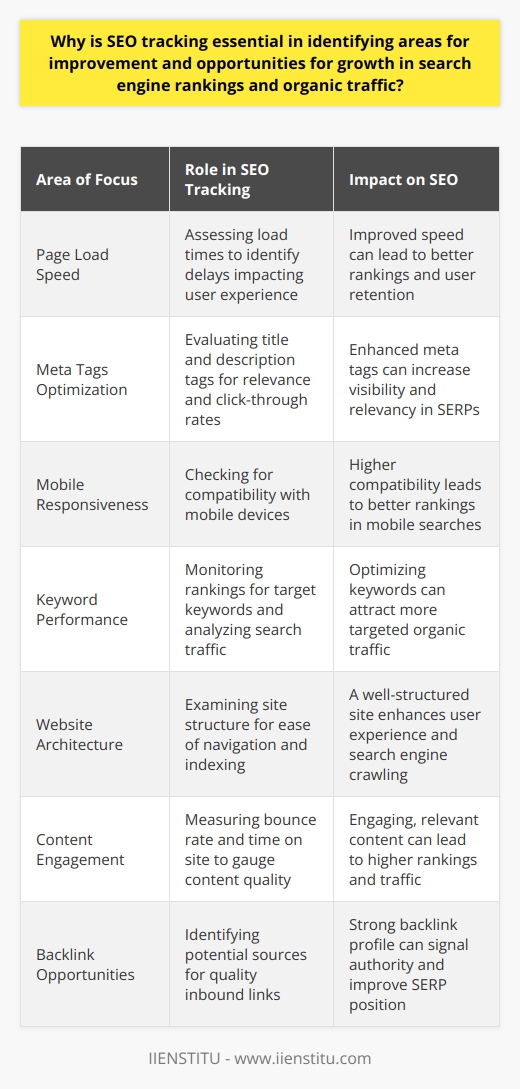
How often should you analyze the impact of website modifications on SEO performance and search visibility to ensure optimum results and continuous improvement?
Frequency of SEO Performance and Search Visibility Analysis
Effective SEO strategies require continuous monitoring. This is due to the dynamic nature of search engine algorithms and user behavior. Analyzing the impact of website modifications should occur weekly.
Key Metrics for Regular Monitoring
For precision, focus on key performance indicators. Assess traffic quantity, quality, organic rankings, and bounce rates. This frequent check ensures your website maintains or improves its search visibility.
Significance of Immediate Analysis after Modifications
After making website modifications, run an immediate post-implementation analysis. It helps to measure the direct impact of changes. The data gathered could be crucial for further improvements.
Benefit of Monthly Analysis for Long-Term Insight
Nevertheless, a comprehensive monthly analysis also proves beneficial. This gives an insight into the long-term effects of the modifications. Not all impacts are immediate, some SEO changes may take weeks to reflect clearly.
Conducting Quarterly Review for Large Scale Decisions
Additionally, conduct a quarterly review for strategic decision making. It helps to analyze trends, patterns, and make large scale SEO decisions. A broader timeframe provides a more in-depth understanding of how your SEO strategies are faring.
Conclusion: Balancing Frequency and Depth of Analysis
In conclusion, balancing the frequency and depth of analysis ensures optimum results. Weekly checks identify immediate issues. A monthly review gives a measure of long-term success. Lastly, a quarterly review fuels strategic decisions. This balanced approach fosters continuous SEO improvement.
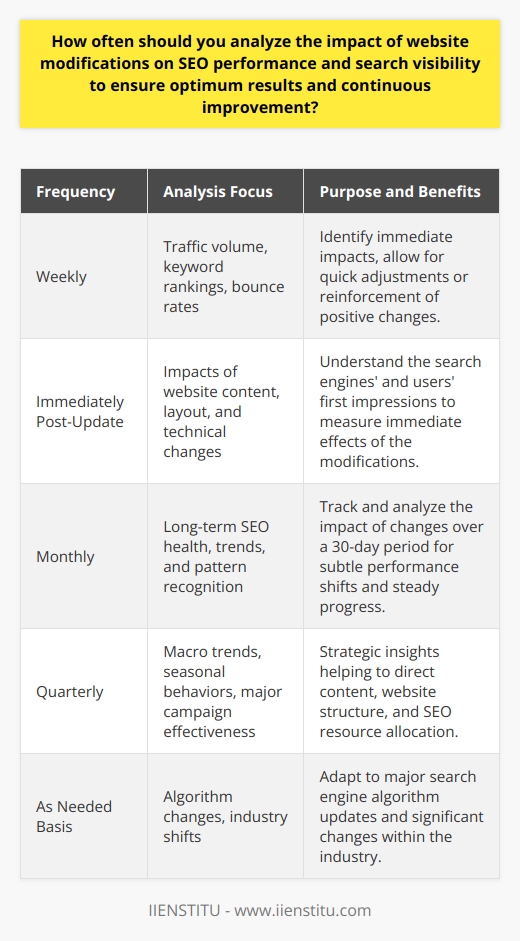
How do I track SEO changes to efficiently adapt and improve website performance?
Monitoring SEO Changes
To efficiently adapt and improve website performance, tracking SEO changes is a vital process. Begin by setting up Google Search Console, an essential tool for monitoring site performance.
Use of Google Search Console
This tool provides crucial insights such as site's organic search traffic, keywords driving the most traffic, and which pages get the most clicks. It also identifies issues affecting site performance. Regularly assess and re-optimize content based on these insights.
Understanding Google Analytics
Another useful tool is Google Analytics. This resource informs about the site's user behavior. This includes how users find the site, their geographical distribution, the devices they use, and their on-site actions. Understanding this data assists in making informed SEO and usability improvements.
Employment of SEO Monitoring Tools
You can also use dedicated SEO tools like SEMrush, Moz, or Ahrefs. These provide information regarding backlink profiles, keyword rankings, and competitor analysis. Examining these aspects can reveal areas of strength and weaknesses, further informing your SEO strategy.
Keeping SEO Algorithm Updates in View
Lastly, keep abreast with Google's frequent algorithm updates. These changes may affect site ranking and performance drastically. By understanding these updates, you can adapt your SEO strategy accordingly to maintain or improve website ranking and visibility.
Content Re-optimization
Based on the insights gained, re-optimize existing content. This could involve updating outdated information, improving meta descriptions and titles, or adding relevant keywords and backlinks.
In summary, efficient tracking of SEO changes requires consistent usage of various tools and resources like Google Search Console, Google Analytics, SEO monitoring tools, and staying updated with algorithm changes. They provide critical insights to help adapt and improve website performance. Consistently optimizing your content based on these insights will ensure that your website stays relevant and performs optimally.
Always prioritize the user experience in all your SEO efforts because ultimately, a highly engaged user translates to a better website performance.
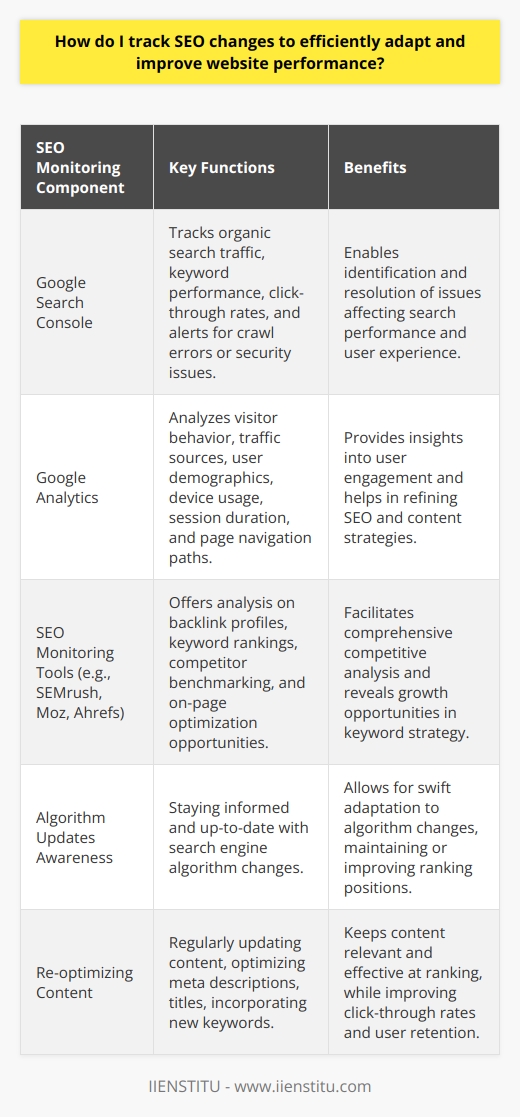
What are the essential aspects to consider in ensuring site optimization for optimal SEO performance and search engine visibility?
Understanding Keywords
A crucial aspect of site optimization for optimal SEO performance is understanding keywords. Conduct thorough keyword research to discover words that users frequently search for. Implement these keywords strategically into your site's content.
Site Structure
Consider the structure of your site. Simplify navigation and ensure that search engines can effortlessly crawl every page. This action eliminates any crawl errors that may hinder search engine visibility.
Quality Content
Content quality directly affects SEO. Creating original, relevant, and engaging content not only attracts visitors but also rates high in SEO. Regularly update your site with this type of content and ensure it aligns with your chosen keywords.
Mobile-Friendly Design
Ensure your website has a mobile-friendly design. A large percentage of users access websites through mobile devices. Search engines often prioritize sites with mobile-friendly design.
Page Load Speed
Pay attention to page load speed. Slow-loading websites frustrate users and negatively influence SEO. Use tools available online to measure your site's speed and make necessary improvements.
Meta Tags
Don't neglect meta tags. When used correctly, meta descriptions, and tags can significantly improve SEO. They provide search engines with relevant information about the content on your page.
Regular SEO Audit
Conduct regular SEO audits. Evaluate your site’s performance, identify shortcomings and devise strategies for improvement.
User Experience
Finally, enhancing user experience should be a priority. Monitor metrics like bounce rate and session duration. Search engines rate websites with better user experience more favorably.
Remember, SEO isn't a one-time process but requires continual optimization to achieve and maintain high visibility on search engines.
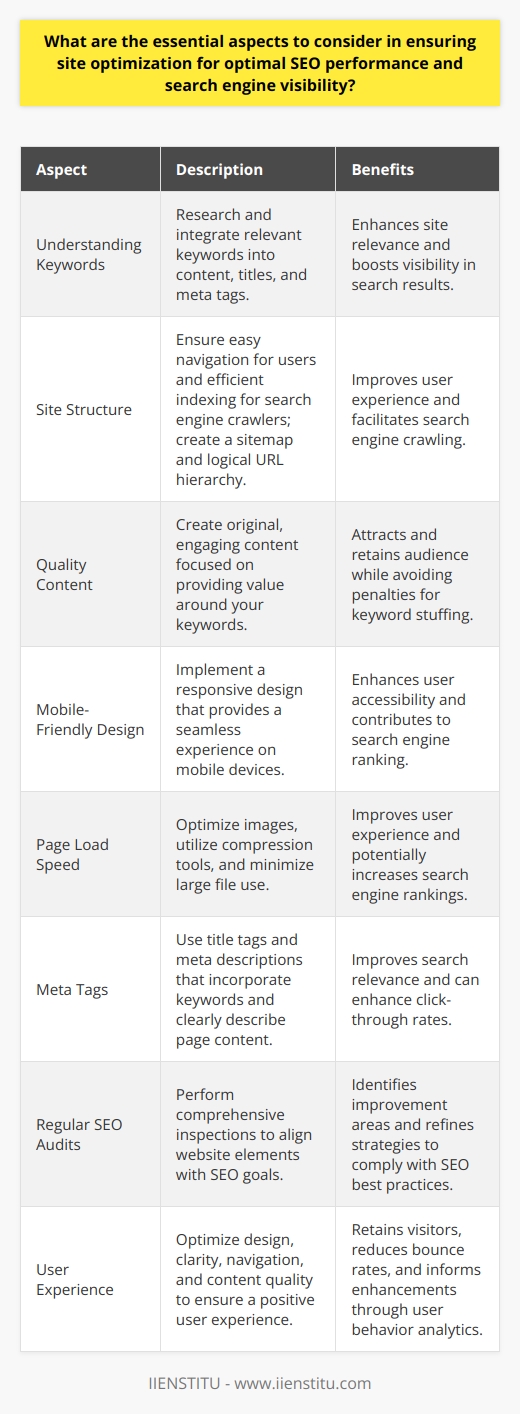
Does updating your website's content and architecture regularly affect SEO and contribute to improved search engine rankings?
Impact of Regular Updates on SEO
Indeed, regular updates to your website's content and architecture can profoundly impact SEO and enhance search engine rankings. Several reasons substantiate this argument.
Influence of Fresh Content
Primarily, search engines prioritize websites that frequently share new and useful content. Updating your content regularly sends a signal that your website is alive and relevant. It offers value to visitors, which search engines acknowledge by improving your website's visibility in search results.
Importance of Keyword Optimization
Moreover, regular content updates provide an opportunity for keyword optimization. SEO depends on the intelligent use of relevant keywords within your content. By updating your blog posts routinely, you can include trending keywords and phrases, thereby increasing chances of higher rankings.
Power of Improved User Experience
Subsequently, redesigning your architecture can enhance user experience, a key ranking metric. Websites with an intuitive, updated structure rank higher as they offer better navigation. This also decreases the bounce rate, which search engines interpret as a positive user interaction.
Role of Link Building
Furthermore, continuous content improvement aids in link building, another SEO factor. Quality backlinks increase as your content becomes more valuable over time with consistent updates. High-quality inbound links significantly impact your website's domain authority and rankings.
Effects of Loading Speed
Lastly, updating the technological aspects of your website like loading speed also influences SEO. Search engines are keen on promoting websites that offer a quick and smooth user experience.
In conclusion, it's evident that both content and architecture updates play a critical role in SEO strategy. Regular updates not only enhance search engine rankings but also build credibility and trust with your audience.
